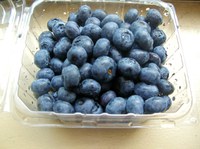Prairie Fare: Naturally Blue Foods Have Antioxidant Power
(Click the image below to view a high-resolution image that can be downloaded)
By Julie Garden-Robinson, Food and Nutrition Specialist
NDSU Extension Service
While my son was in elementary school, he became enamored with blue foods. Whenever blue was an option for snow cones or other treats, he chose the food with his favorite color. He especially liked a popular type of cereal available when he was young. It colored the milk blue.
I think he enjoyed getting a blue tongue and lips to show me, especially when I wasn’t expecting it.
Blue foods in nature are a rarity. My son’s favorite treats were not naturally blue foods. They were colored by a mixture of purple and blue artificial dyes.
Artificial colorants are safe food additives, but they do not provide the health benefits linked with naturally occurring pigments. According to researchers, adding more naturally vibrant foods to your diet is good for your health.
Blueberries in particular are linked with health benefits. According to a U.S Department of Agriculture study of more than 40 fruits and vegetables, blueberries ranked high in antioxidant activity. A 1/2-cup serving of blueberries had as much ""antioxidant power"" as five servings of other fruits and vegetables.
Antioxidants help neutralize the damaging effects of ""free radicals,"" which are substances that damage DNA and cell membranes. The damage caused by free radicals is linked with cancer, heart disease and the aging process.
Scientists extracted the protective chemicals from blueberries, strawberries and spinach. They fed aging rats a diet rich in one of the extracts. The rats fed blueberry extract came out on top in tests of balance and coordination.
Blueberry and strawberry extracts were associated with protection against age-related changes in the brain. Rats fed any of the extracts performed better in memory-associated tasks than the rats that didn’t consume the extract.
If you have a test to take, however, don’t expect that eating blueberries will have an immediate effect.
Do you want to learn more about nutrition and your brain? See http://www.ndsu.edu/boomers for additional blueberry recipes and brain information. Click the Facebook link to get more information directly and check out the Pinterest page.
Other research has linked blueberries and other antioxidant-rich foods with protection against heart disease and stroke. Blueberries also may provide protection from urinary tract infection.
Although blueberries have gotten a lot of publicity, all fruits and vegetables provide ample nutrition. Research continues to grow regarding the health benefits of eating at least 4 1/2 cups of fruits and vegetables daily. Enjoy the benefits of colorful produce, and fill half of your plate with a variety of colorful fruits and vegetables.
Try more blue-purple foods such as blueberries, blackberries, purple cabbage and blue potatoes. All of these contain the antioxidant anthocyanin.
Experiment a little. Make a frosty berry smoothie by blending 1/2 cup of yogurt, 1/2 cup of orange juice and a 1/2 cup of frozen berries. Top frozen yogurt with berries. Have some blueberries on your oatmeal or other whole-grain cereal.
This tasty snack comes from the North American Blueberry Council.
Blueberry Granola Bars
1/2 c. honey
1/4 c. firmly packed brown sugar
3 Tbsp. canola oil
1 1/2 tsp. ground cinnamon
1 1/2 c. quick-cooking oats
2 c. fresh blueberries
Preheat oven to 350 degrees. Lightly grease a 9- by 9-inch square baking pan. In a medium saucepan, combine honey, brown sugar, oil and cinnamon. Bring to a boil and boil for two minutes; do not stir. In a large mixing bowl, combine oats and blueberries. Stir in honey mixture until thoroughly blended. Spread into prepared pan, gently pressing mixture flat. Bake until lightly browned, about 40 minutes. Cool completely in the pan on a wire rack. Cut into 1 1/2- by 3-inch bars.
Makes 18 bars. Each bar contains 95 calories, 3 grams (g) of fat, 16 g of carbohydrate and 1 g of protein.
(Julie Garden-Robinson, Ph.D., R.D., L.R.D., is a North Dakota State University Extension Service food and nutrition specialist and professor in the Department of Health, Nutrition and Exercise Sciences.)
NDSU Agriculture Communication – July 10, 2014
| Source: | Julie Garden-Robinson, (701) 231-7187, julie.garden-robinson@ndsu.edu |
|---|---|
| Editor: | Rich Mattern, (701) 231-6136, richard.mattern@ndsu.edu |


